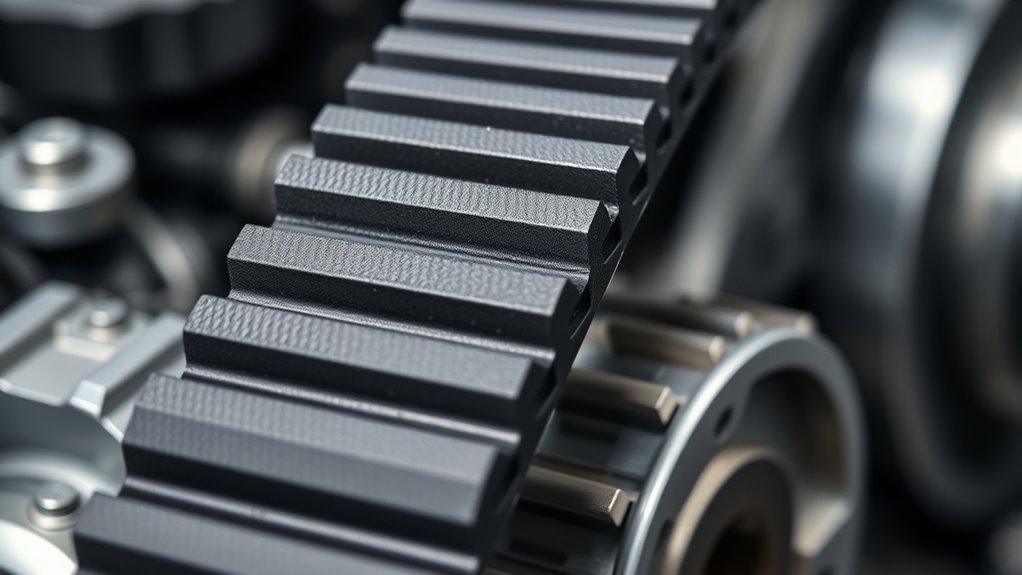A timing belt is a crucial engine part that keeps the crankshaft and camshaft rotating together, ensuring your engine’s valves open and close at the right times. If it wears out or breaks, it can cause serious engine damage. Most vehicles need a timing belt replaced every 60,000 to 100,000 miles, but check your owner’s manual for specifics. Keep an eye on signs of wear, and if you’re curious about how to maintain it, there’s more to learn.
Key Takeaways
- The timing belt synchronizes engine components like the crankshaft and camshaft for smooth operation.
- It’s typically recommended to replace the timing belt every 60,000 to 100,000 miles.
- Signs of wear include cracks, fraying, missing teeth, or engine misfires, indicating it’s time for replacement.
- Proper installation and replacing related parts like tensioners prevent future failures and engine damage.
- Routine inspections and timely replacements help avoid costly repairs and ensure engine longevity.

Have you ever wondered what keeps your engine running smoothly and efficiently? The answer lies in the timing belt, a essential component that ensures your engine’s internal parts move in perfect harmony. Proper belt maintenance is fundamental because, over time, the belt can wear out, stretch, or even break, leading to serious engine damage. The primary role of the timing belt is to maintain engine synchronization, coordinating the rotation of the crankshaft and camshaft so that the valves open and close at just the right moments during each cycle. When the timing belt functions correctly, your engine runs smoothly, fuel efficiency stays high, and you avoid costly repairs. But if it slips or fails, the consequences can be severe, including bent valves, piston damage, or complete engine failure. That’s why knowing when to replace your timing belt is critical for protecting your vehicle and ensuring consistent performance.
The timing belt typically needs replacement every 60,000 to 100,000 miles, but this varies depending on the vehicle make and model. Always consult your owner’s manual to find the manufacturer’s recommended interval. Regular belt maintenance involves inspecting the belt for signs of wear, such as cracks, fraying, or missing teeth, especially if your vehicle is approaching the mileage limit. Many mechanics recommend replacing the belt proactively before it shows visible signs of deterioration, as a sudden failure can leave you stranded and lead to costly repairs. When replacing the timing belt, it’s also wise to change related components like the tensioner and pulleys, which can wear out over time. Proper installation guarantees ideal engine synchronization, preventing misfires or uneven running. Additionally, understanding the role of projector contrast ratio can help you better appreciate high-quality engine performance, much like how contrast ratio affects visual clarity in displays.
Keeping up with scheduled maintenance helps you avoid unexpected breakdowns and keeps your engine running at peak performance. It’s not just about replacing the belt; it’s about caring for the entire timing system. An overlooked or neglected timing belt can catastrophically disrupt engine timing, causing valves to collide with pistons, which is one of the most damaging scenarios you could face. That’s why routine inspections, timely replacements, and trusting a qualified mechanic are key to maintaining your vehicle’s health. Remember, a well-maintained timing belt isn’t just about avoiding breakdowns—it’s about ensuring your engine’s longevity and reliability. When it’s time for a replacement, don’t delay, because proactive belt maintenance and precise engine synchronization are the best ways to keep your car running smoothly for miles to come.
Frequently Asked Questions
How Can I Tell if My Timing Belt Is Failing?
You can tell if your timing belt is failing by listening for squealing or chirping noises, which indicate belt tension issues. Check for visible cracks, fraying, or glazing on the belt. Also, verify pulley alignment is correct; misaligned pulleys can cause uneven wear. If the belt feels loose or you notice difficulty starting your engine, it’s time to have it inspected and replaced to prevent serious engine damage.
What Are the Signs of Timing Belt Wear?
Think of your timing belt like a watch’s precision; when it shows signs of wear, your engine struggles. You’ll notice cracks, fraying, or missing teeth during belt inspection. Squealing noises or engine misfires also signal trouble. Check wear indicators for early warning signs. If these symptoms appear, it’s time to replace the belt promptly, preventing costly engine damage and keeping everything running smoothly.
Can I Replace a Timing Belt Myself?
Yes, you can replace a timing belt yourself if you have DIY repair skills and the right tool requirements. Start by gathering necessary tools like a wrench set, screwdrivers, and a torque wrench. Follow a detailed repair guide specific to your vehicle. Keep in mind, this task requires patience, precision, and safety precautions. If you’re unsure, consider consulting a professional to avoid potential engine damage.
What Are the Risks of Ignoring Timing Belt Replacement?
Ignoring timing belt maintenance risks severe engine damage, especially if it snaps unexpectedly. When the timing belt fails, your engine’s timing gets thrown off, potentially causing pistons and valves to collide. This can lead to costly repairs or even engine replacement. To avoid these risks, replace your timing belt as recommended by your vehicle’s manufacturer, ensuring proper engine timing and reliable performance. Don’t delay — regular maintenance keeps your engine running smoothly.
How Does a Timing Belt Differ From a Serpentine Belt?
A timing belt differs from a serpentine belt mainly in function and materials. The timing belt synchronizes engine valves and pistons, often made from high-strength rubber with fiberglass or Kevlar fibers for durability. The serpentine belt drives accessories like the alternator and AC compressor. You should follow maintenance intervals for both, usually replacing the timing belt every 60,000 to 100,000 miles, to prevent engine damage, and inspecting the serpentine belt regularly for wear.
Conclusion
If your timing belt fails, it can cause serious engine damage—like what happened to Lisa, who skipped her scheduled replacement. Her car’s engine seized, costing her thousands in repairs. Don’t let that happen to you. Regularly check your owner’s manual and replace the belt at the recommended interval. Staying proactive keeps your engine running smoothly and helps you avoid costly breakdowns. Remember, a small maintenance task saves you big headaches later.









